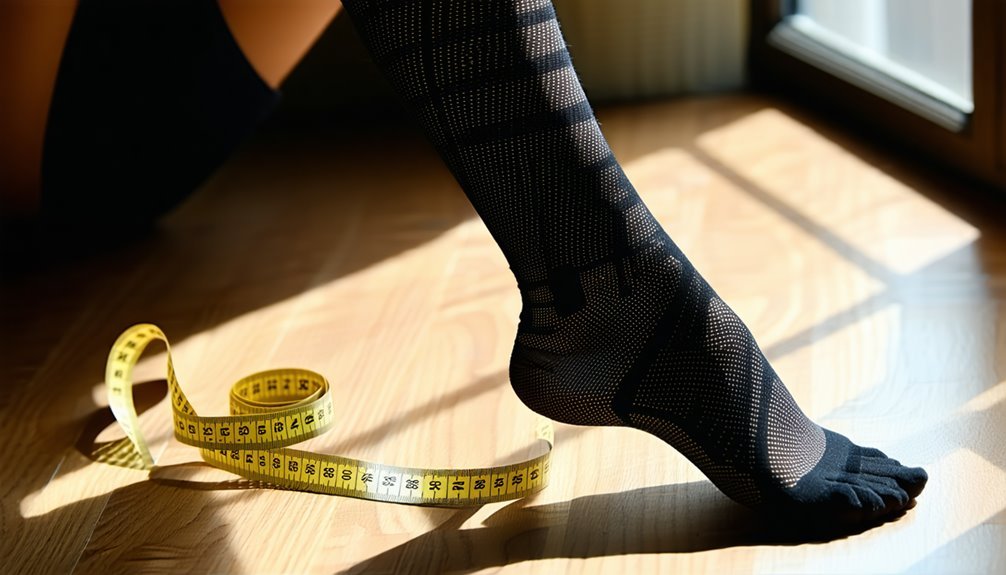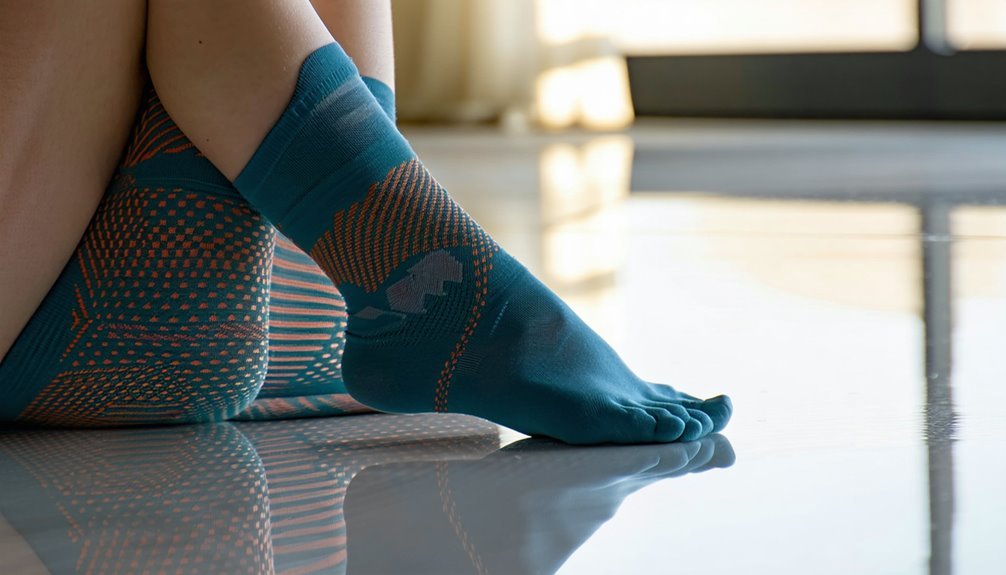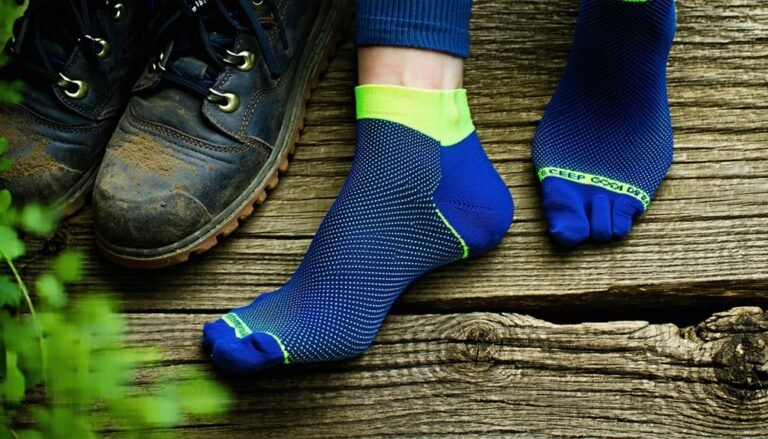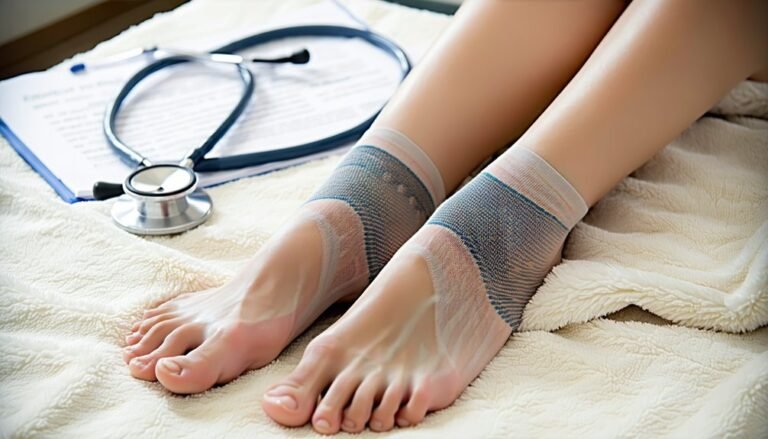How Do Compression Socks Work
Compression socks work by applying graduated pressure to your legs, with the highest compression at the ankle. This design promotes blood flow toward the heart, reducing venous pressure and preventing swelling. By encouraging venous return, they help alleviate discomfort during long periods of inactivity and improve oxygen delivery to your muscles. They're beneficial for various conditions and activities. There's more to discover about their benefits and types to find the right fit for your needs.
Understanding Compression Socks

Compression socks are specialized garments designed to apply graduated pressure to the legs and feet. The history of compression socks dates back to the 19th century when elastic materials were first used to aid circulation. Today, these socks are typically made from a blend of nylon, spandex, and other compression sock materials that enhance elasticity and durability. The design guarantees that pressure is highest at the ankle and gradually decreases up the leg, promoting better blood flow. By wearing compression socks, you can potentially reduce the risk of conditions like deep vein thrombosis (DVT) or varicose veins. Always consult a healthcare professional before use, especially if you have underlying health conditions, to guarantee safety and proper fit.
The Mechanism of Graduated Compression
Graduated compression socks apply varying levels of pressure to your legs, which enhances blood flow back to the heart. This pressure gradient effectively reduces venous pressure, helping to prevent swelling and improve circulation. Understanding this mechanism is essential for maximizing the benefits of wearing compression socks.
Blood Flow Improvement
Improved blood flow is a key benefit of wearing compression socks, and this is largely due to the principle of graduated compression. These socks exert varying levels of pressure on your legs, with the highest compression at the ankle and decreasing as it moves up your calf. This design promotes better blood circulation by helping to push blood upward toward your heart, enhancing venous return. As a result, you may experience reduced swelling and discomfort, especially during long periods of sitting or standing. By supporting venous function, compression socks can also lower the risk of blood clots and improve overall leg health. For those concerned about circulation issues, wearing compression socks can be a safe and effective solution.
Pressure Gradient Effects
When you wear compression socks, the varying levels of pressure create a pressure gradient that plays a crucial role in enhancing venous return. This gradient exerts higher pressure at the ankle, gradually decreasing up the leg. Such a design promotes ideal circulation dynamics, facilitating blood flow back to the heart. As the pressure decreases, it helps prevent blood pooling in the lower extremities, reducing the risk of conditions like varicose veins and deep vein thrombosis. By supporting the venous system, these socks efficiently enhance overall circulation, ensuring your legs feel more energized and less fatigued. Understanding this mechanism can reassure you of the safety and effectiveness of graduated compression in maintaining healthy blood flow.
Benefits of Wearing Compression Socks
While many people might not realize it, wearing compression socks can offer significant benefits for your overall health and well-being. These specialized garments provide graduated pressure, which helps improve circulation in your legs. By applying pressure to the lower limbs, compression socks facilitate the return of blood to the heart, reducing the risk of blood pooling. This enhanced circulation is particularly beneficial during prolonged periods of sitting or standing. Additionally, compression socks can lead to reduced swelling, alleviating discomfort associated with fluid retention. Whether you're an athlete or someone who spends long hours on your feet, incorporating compression socks into your routine can contribute to better leg health and overall comfort, ensuring you feel your best throughout the day.
Conditions That May Require Compression Socks
Certain medical conditions may necessitate the use of compression socks to help manage symptoms and promote better circulation. If you experience any of the following, compression socks might be beneficial:
- Varicose veins: These swollen veins can cause discomfort and require support.
- Chronic venous insufficiency: This condition leads to poor blood flow in the legs, often resulting in swelling and pain.
- Deep vein thrombosis (DVT): Compression socks can help prevent blood clots in those at risk.
- Post-surgical recovery: After certain surgeries, they aid in circulation and reduce the risk of complications.
Consulting a healthcare professional is essential before starting any compression therapy, ensuring it's safe and appropriate for your specific condition.
Different Types of Compression Socks

Compression socks come in various types, each designed to address specific needs and levels of compression. You'll find graduated compression socks, which offer the highest compression at the ankle, gradually decreasing up the leg. This design enhances blood flow and alleviates swelling. Athletic compression socks are another type, tailored for performance and recovery, providing support during physical activities. They can help reduce muscle fatigue and soreness. Additionally, there are knee-high and thigh-high options, catering to different preferences and situations. Some compression sock types also focus on therapeutic uses, such as post-surgery recovery or managing chronic conditions. When selecting a type, it's essential to take into account your specific requirements for safety and effectiveness.
How to Choose the Right Compression Socks
How do you determine the right compression socks for your needs? Start by considering the intended purpose, as different conditions require specific compression levels. It's vital to consult a healthcare professional to guarantee you choose the appropriate pressure for your situation.
Next, evaluate the fabric materials. High-quality, breathable fabrics can enhance comfort and guarantee effective compression.
Consider these factors:
- Compression Levels: Ranging from mild to medical-grade, select according to your needs.
- Sock Length: Choose between knee-high, thigh-high, or full-leg options.
- Size and Fit: Accurate measurements are essential for effectiveness.
- Style and Design: Opt for styles that suit your daily activities and preferences.
Tips for Wearing Compression Socks Effectively
To wear compression socks effectively, proper sizing is essential; ill-fitting socks can hinder benefits. Start with a gradual wear approach, allowing your body to adapt to the increased pressure. This strategy guarantees comfort and maximizes the socks' effectiveness throughout the day.
Proper Sizing Matters
Finding the right size for your compression socks is essential for maximizing their effectiveness. Proper sock fitting guarantees that the compression is applied evenly, reducing the risk of potential issues. To achieve the best results, follow these tips for size measurement:
- Measure your ankle, calf, and thigh circumference, if applicable.
- Refer to the manufacturer's sizing chart for accurate fit.
- Consider both length and width for a snug, yet comfortable fit.
- Test the socks to verify they don't slip down or irritate your skin.
Incorrect sizing can lead to discomfort or ineffective compression, so take the time to measure accurately. Prioritize your safety and well-being by choosing the appropriate size for your compression socks.
Gradual Wear Approach
Although you may be enthusiastic to experience the benefits of compression socks, it's important to introduce them gradually into your routine. Start by wearing them for just a few hours each day. This gradual increase in wear time allows your body to adapt to the compression without causing discomfort. Aim for a daily routine that incorporates wearing the socks during activities where you'll be on your feet or sitting for extended periods. As your comfort level rises, you can increase the duration. Listen to your body; if you experience any pain or excessive discomfort, reduce the wear time. Following this approach will help guarantee you reap the full benefits of compression socks safely and effectively.
Frequently Asked Questions
Can Compression Socks Be Washed and Reused?
Yes, you can wash and reuse compression socks. It's recommended to wash them after every use to maintain hygiene and support. Proper washing can extend their lifespan, ensuring they continue to provide effective compression and comfort.
How Long Can I Wear Compression Socks Each Day?
You can typically wear compression socks for 8 to 12 hours daily, depending on your needs. Always follow daily usage recommendations to guarantee safety and effectiveness, adjusting duration based on comfort and any specific medical advice.
Are There Any Side Effects of Wearing Compression Socks?
Wearing compression socks can be like a tight hug for your legs, but there are potential risks and side effects. You might experience discomfort, skin irritation, or restricted circulation if they're worn improperly or too long.
Do Compression Socks Help With Swelling During Pregnancy?
Compression socks can help reduce swelling during pregnancy by providing varying compression levels. These pregnancy benefits support better circulation, alleviating discomfort. Always consult your healthcare provider to ascertain they're safe and suitable for your specific situation.
Can I Wear Compression Socks While Exercising?
Wearing compression socks while exercising can be like having a supportive friend by your side. They offer exercise benefits by improving circulation, but guarantee a proper sock fit for safety and peak performance during your workouts.







